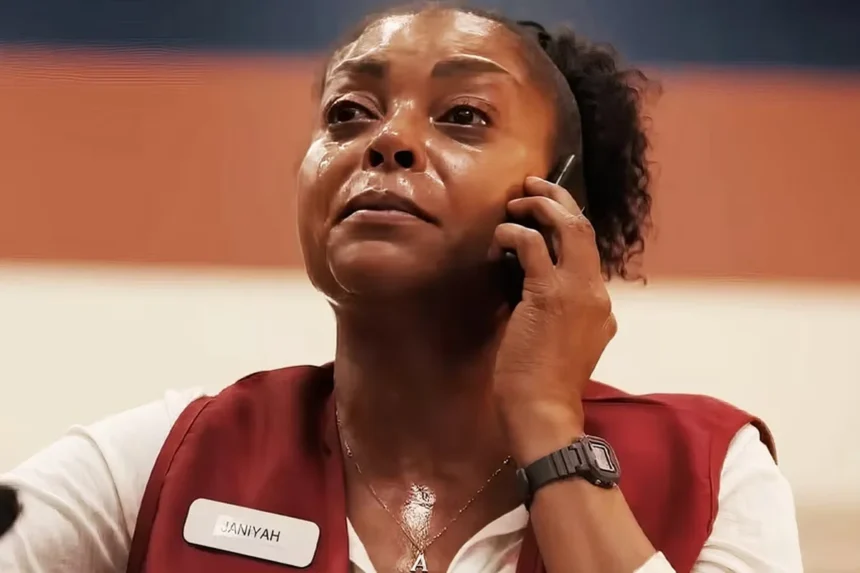Janiyah Wilkerson True Story? When the film Straw premiered on Netflix, viewers were moved by the harrowing journey of Janiyah Wiltkinson (played by Taraji P. Henson). Many asked: is Janiyah Wilkerson / Wiltkinson a real person? Is the story based on true events? In this article, we’ll explore what is factual, what is fictional, and why her story resonates so deeply.
Who Is Janiyah Wiltkinson in Straw?
Janiyah Wilkerson True Story? In Straw, Janiyah Wiltkinson is depicted as a single mother who faces a cascade of crises over the course of a single, devastating day. She’s trying to care for her young daughter Aria, who suffers from seizure episodes, while juggling unstable employment, eviction threats, mounting medical bills, and systemic obstacles.
Her circumstances spiral when she is falsely accused by her employer of theft, denied access to her funds, and pushed into desperate measures—culminating in a bank robbery situation she never intended.
Additionally, the film illustrates her mental and emotional decline under pressure, how every setback compounds, and how a person under extreme stress can reach a breaking point
Thus, Janiyah’s role is not just that of a protagonist in crisis, but also a lens on systemic failure, desperation, and how society treats its most vulnerable.
Is Janiyah Wilkerson Based on a True Person?
A central question many ask is: Is Janiyah Wilkerson (or Wiltkinson) a real person? The short answer: No.
- Multiple sources confirm that Straw is a fictional story, and Janiyah Wiltkinson is a crafted character, not based on a known real individual.
- In interviews, when asked if the story is “true,” the creators clarify that while Straw draws on real emotional and social influences, it does not depict a real person or specific true events.
- One article states: “Janiyah is not based on a real person. She is a fictional character invented by Tyler Perry.”
However, that doesn’t mean the story lacks real-world resonance. Tyler Perry has said he was inspired by his own life, everyday people’s struggles, and songs like Angie Stone’s “20 Dollars” when writing it.
Therefore, while Janiyah Wilkerson’s name and incidents are not historical fact, Straw uses a fictional narrative to reflect real pain, hardship, and systemic inequality.
Themes & Social Issues in Janiyah’s Story
Though fictional, Janiyah’s journey touches on multiple powerful themes that reflect real societal problems.
1. Economic Instability & Poverty
Janiyah’s struggles with job loss, eviction, and lack of financial safety nets mirror the daily challenges many low-income individuals face. The film spotlights how small disruptions (missed wage, medical expenses) can cascade into life-threatening crises.
2. Healthcare Burdens & Chronic Illness
Her daughter Aria’s medical condition (seizures) demands treatment and resources, but health systems and costs push Janiyah to extremes. This highlights how caring for sick children can strain families already on edge.
3. Systemic Discrimination & Injustice
Janiyah is framed by her employer, denied access to funds, questioned by institutions, and pushed by structural forces. These plot points critique systems that disproportionately penalize the marginalized.
4. Mental Health & Emotional Collapse
Under relentless pressure, Janiyah’s emotional state fractures. The film shows how mental health can deteriorate under chronic stress, especially when people feel unseen, unheard, or trapped.
5. Sacrifice, Motherhood & Identity
Janiyah’s identity is tied to being a mother—her sacrifices, fears, and agency revolve around protecting her child. Her desperation forces her to make impossible choices, raising questions about agency under survival.
6. Collective Empathy & Mobilization
Though the story is centered on Janiyah, it shows how others around her—co-workers, bank staff, law enforcement—can either worsen or help. It probes how communities respond to pain, crisis, and desperation.
These themes make Janiyah’s fictional story feel urgent and possible, resonating widely across audiences.
Why the Confusion About “True Story”?
Given the emotional realism of Straw and how closely Janiyah’s experiences echo real life, it’s no surprise people assume she’s based on a true story. Some factors contributing to that confusion include:
- Authentic depictions: The film’s detail in everyday struggles, systemic failures, and emotional collapse feels raw and believable.
- Creator statements: Tyler Perry has said he drew from real life, from his own struggles. That creates the impression that characters may be based on people he’s known.
- Media discussions: Some articles refer to influences of real life and “real-life influences” in the story.
- Online claims: Social media tags and users sometimes hint that it is a “true story,” amplifying the notion that Janiyah existed.
- Human tendency: We often assume emotionally compelling stories must “really have happened”—especially those featuring distress, injustice, or tragedy.
Because of all this, many people ask “Janiyah Wilkerson true story?”—and the most accurate answer is: a fictional story rooted in emotional truth, not a literal biography.
Impact & Reception of Janiyah’s Story
Even as a fictional character, Janiyah Wiltkinson has sparked strong reactions. Here’s how her story has landed with audiences and critics:
Critical Praise for Portrayal
Taraji P. Henson’s performance has been praised for capturing the anguish, desperation, and nuance of a woman nearing her breaking point. Critics note how Straw pushes viewers to question how many pushed-to-limit stories happen off screen.
Discussions on Social Media
The film has prompted conversation around poverty, race, mental health, and systemic barriers—especially for Black mothers. Many viewers treat Janiyah’s story as emblematic of struggles they or people they know have faced.
One article even frames it as a “story about power, pressure, and people,” placing Janiyah at the intersection of multiple social dynamics.
Awareness & Empathy Building
By depicting a precipitous fall in a single day, Straw invites empathy for those burdened by chronic strain. The emotional gut punch of Janiyah’s arc encourages viewers to consider unseen fights carried by people around them.
Critique & Debate
Some critics question whether the film leans too heavily into tragedy tropes or whether it simplifies complex issues for dramatic effect. Others debate whether it unfairly punishes its protagonist—or whether the systems in the story are given enough agency. Still, the controversy also increases engagement and discussion.
Cultural Resonance
Because the film and Janiyah’s story reflect urgent social anxieties (housing insecurity, healthcare costs, racial inequality), the character has become a reference point in cultural debates—despite her fictional status.
Conclusion: The Power of Fictional Truth
While Janiyah Wilkerson / Janiyah Wiltkinson might not have walked the earth, her story in Straw holds emotional truth that connects with real experiences. She is a fictional character, deliberately crafted by Tyler Perry and his team, not a biographical account of a real person.
Yet, the confusion over “true story” is understandable: Straw mirrors harsh realities many people face daily, in systems that fail those who are already vulnerable. Her narrative becomes a metaphor—a dramatic portrait of what can happen when the safety nets unravel, and a person is pushed to the brink.
If you like, I can also write a short fact-check infographic separating what’s real vs. fabricated in Janiyah’s story, or a comparison of Straw with real cases of mothers in crisis.






